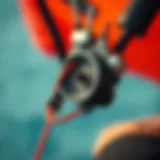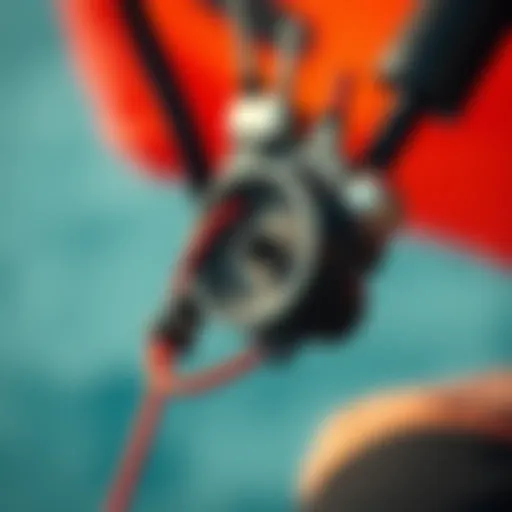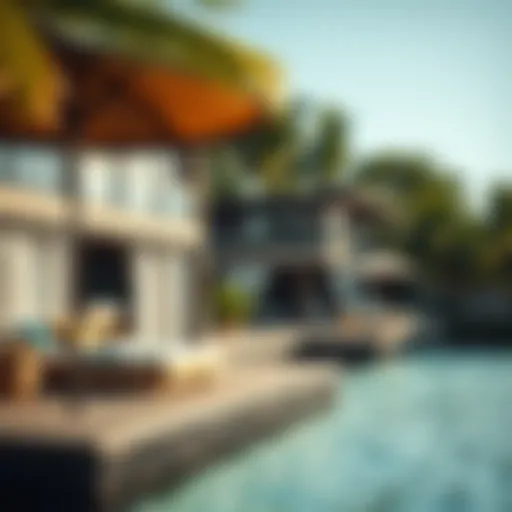Essential Guide to Buying Kitesurf Equipment
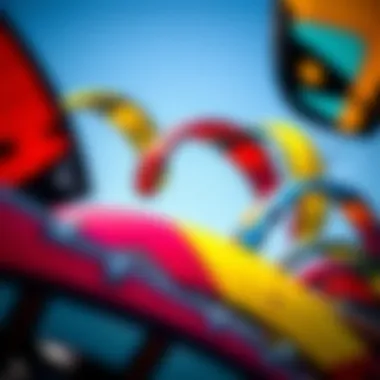

Intro
Kitesurfing has grown in popularity, captivating thrill-seekers and water sports enthusiasts alike. For many, it’s not just a hobby; it’s a lifestyle. However, diving into this exhilarating sport can be intimidating, primarily when it comes to selecting the right equipment. With numerous options available—each catering to different skill levels and riding styles—making sense of it all can feel like trying to navigate through a storm without a compass.
In this guide, we break down the essentials you need to consider when purchasing kitesurf equipment. Whether you're a seasoned pro or a newbie wanting to ride the waves, our aim is to simplify the process and help you make informed decisions. We’ll address the critical factors, including understanding types of kites and boards, evaluating safety gear, and recognizing how local conditions can impact your choices.
Think of this guide as your treasure map, drawn up to lead you through the maze of equipment specifications, prices, and brands. Your kitesurfing journey deserves the right foundation, so let’s get started.
Foreword to Kitesurf Equipment
Kitesurfing, a thrilling sport that merges the elements of surfing and flying, relies heavily on appropriate equipment for a safe and enjoyable experience. Understanding kitesurf equipment is not merely about choosing the right kite or board; it's an intricate process that involves comprehension of your personal needs, local conditions, and budget constraints.
When delving into kitesurfing, one might find the sheer volume of options a tad overwhelming. With various types of kites, boards, safety gear, and additional accessories available, each element serves a critical function that can significantly influence performance and safety. A kite is not just a colorful fabric soaring through the air; it’s the launchpad for your adventures across the water. The right board complements the kite, allowing for smoother rides and easier handling.
Moreover, safety cannot be understated. Proper gear ensures that riders can enjoy their time without the nagging fear of what-ifs. Each piece of safety equipment—whether it's a harness or a helmet—plays an essential role in protecting riders from potential hazards.
In this guide, we peel back the layers of kitesurf equipment step by step. By outlining the types of kites and boards available, we aim to equip aspiring kiteboarders with the knowledge needed to make informed choices. Besides that, considering unique environmental conditions, such as wind patterns and water terran, is vital so that every rider can prepare for the challenges they may encounter.
Ultimately, understanding kitesurf equipment creates the backbone of any kiteboarding journey. It allows kiteboarders—from rookies to seasoned pros—to tailor their gear to fit their unique style and preferences. Exploring this field is not only an investment in equipment but also an investment in experiences that can lead to exhilarating moments on the water.
"The kite is your connection to the wind; choose it wisely!"
Whether you’re starting fresh or looking to upgrade, knowing what to seek in kitesurf equipment is invaluable. Let's take a closer look at what types of kites are out there and how to choose the right one for your kitesurfing escapades.
Understanding Kites
When it comes to kitesurfing, the kite is your main engine. Understanding the different types of kites, their characteristics, and how they impact your ride are crucial to becoming a proficient rider. Choosing the right kite can vastly transform your experience on the water. Knowing the intricacies of how each type works will empower you to make informed decisions and maximize your fun out there. Often, it's the difference between a thrilling session and a struggle. This section dives into the specifics of kites, highlighting essential elements that every kitesurfer should consider.
Types of Kites
Kites are not a one-size-fits-all kind of deal. Each variety has its unique traits that cater to different styles and conditions. Three major types command attention: Leading Edge Inflatable Kites, Foil Kites, and Hybrid Kites. These options allow riders to select based on their preference, local conditions, and skill levels.
Leading Edge Inflatable Kites
Leading Edge Inflatable Kites, or LEIs, are often the most popular choice among beginners and seasoned riders alike. Their structure includes inflatable bladders that create a rigid framework, allowing the kite to hold its shape in various wind conditions.
Advantageous Characteristics: LEIs are known for their stability and ease of use. They are forgiving, making them suitable for those learning to navigate the waves. Because of their design, they can also handle overpowered conditions without causing too much strain on the rider.
Unique Features: The ability to deflate and pack them into a compact size is a game-changer for travelers. However, if you receive a puncture, repairs can be tricky and sometimes requires specialized handling.
Foil Kites
Foil Kites are a different breed and present a compelling option for those looking to level up their kitesurfing game. They do not use bladders but rely on a series of cells that fill with air, which effectively supports the kite when in use. This design allows for exceptional light-wind performance, making them ideal for those days when the breeze isn’t kicking up much.
Key Characteristics: Foil kites deliver a responsive feel and can boost impressive lift when mastered. They're often lighter than their inflatable counterparts, which many kiteboarders appreciate for ease in handling.
Considerations: However, Foil Kites might require a steeper learning curve and can be less forgiving in turbulent wind conditions.
Hybrid Kites
Hybrid Kites try to bridge the gap between LEIs and Foils, combining elements from both to create a versatile ride. These kites showcase the characteristics of stability and power alongside the delicate responsiveness of a foil.
Why Hybrid? If you’re looking for adaptability, hybrids can shine in multiple wind and water conditions, making them a fair choice for riders who dabble in different riding styles.
Unique Characteristics: They act as a one-kite-fits-all solution for many. Nonetheless, they may not excel in the unique aspects that pure LEIs or foils do, offering an average performance in comparison, which some advanced riders might find unsatisfactory.
Choosing the Right Kite Size
Picking the right size kite can feel like finding a needle in a haystack, but it doesn’t have to be that complicated. The considerations go beyond just the kite itself, extending into the rider’s weight, the prevailing wind conditions, and personal riding style.
Weight Considerations
Your weight influences the size and type of kite you should be using. A heavier rider often needs a larger kite to generate sufficient lift and power.
Why It Matters: If your kite isn’t appropriately sized for your weight, you can find yourself underpowered on softer rigs or overwhelmed in stronger winds. It’s really about finding that sweet spot.
Unique Perspective: Learning to navigate kite flying with a kite that’s aligned with your weight can greatly enhance your confidence and capabilities in the water.
Wind Conditions
Every kitesurfer knows that wind conditions can make or break a kitesurfing session. The wind speed can help determine the ideal kite size—too small, and you may struggle; too large, and you can feel overpowered and unsafe.
The Key Aspects: You’ll find lighter winds often call for larger kites, while higher wind conditions benefit from smaller kites.
Important Note: Understanding local wind patterns and seasonal changes can help you adapt your kite size for optimum performance in various conditions.
Riding Style
Your personal riding style adds another layer to the kite sizing equation. Freestyle, wave riding, and cruising all require different kinds of handling and power.
What to Think About: If you prioritize tricks and jumps, you might prefer a smaller kite that offers responsiveness. On the other hand, flat water cruisers might desire larger kites for smoother rides.
Unique Characteristics: The differences in styles can shape how you perceive the wind, which ultimately influences your choice of equipment. It’s vital to align your gear to complement your preferred riding techniques and position on the water.
Selecting the Right Board
When it comes to kitesurfing, selecting the right board can make all the difference between a thrilling experience and an absolute nightmare. The board you choose should align with your skill level, riding style, and the conditions you typically encounter. Understanding the nuances of various boards enables you to ride confidently and enjoyably.
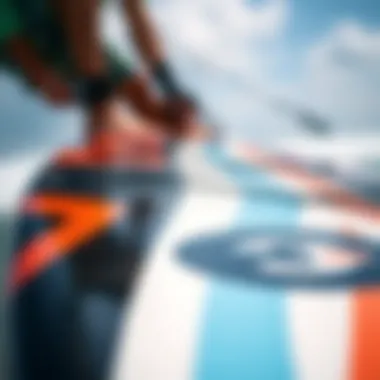
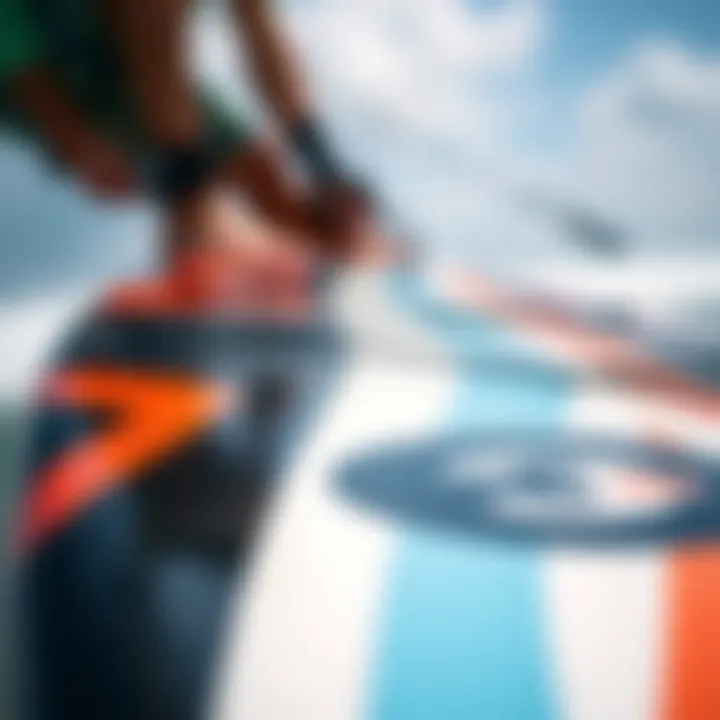
Types of Kitesurf Boards
Different types of boards cater to specific styles and experiences in kitesurfing. Choosing the right one depends on how you intend to use it. Here’s a closer look.
Directional Boards
Directional boards are primarily designed for wave riding and freestyle kiteboarding. A key characteristic of these boards is their elongated shape, which gives them excellent control and stability while carving through waves. This aspect is what makes them favored among riders who enjoy surfing-style maneuvers on water.
Unique Feature: The ability to ride almost like a traditional surfboard allows for a seamless transition from waves to freestyle tricks.
Advantages and Disadvantages: While they excel in choppy conditions, you might find them less versatile on flat water, as they are generally not designed for jumping. Thus, if you're keen on exploring waves, a directional board could be the ticket.
Freestyle Boards
Freestyle boards are built for tricks, jumps, and aerial maneuvers. They generally have a shorter length and wider stance, giving riders the pivot they need for complex aerial acrobatics. This makes them a popular choice among those who want to showcase their skills.
Unique Feature: The design often includes reinforced edges to minimize chipping and improve durability, allowing riders to practice their tricks with less worry.
Advantages and Disadvantages: While they excel in jumps, they may not perform as well in light wind conditions or in wave riding. If your goal is to nail that next trick, a freestyle board will boost your performance considerably.
Twin-Tip Boards
Twin-tip boards are perhaps the most versatile option in the kitesurfing scene, suitable for both beginners and experts alike. This board features a symmetrical design that allows for riding in either direction. This is especially advantageous for those just starting.
Unique Feature: The ease of switching directions means beginners can feel more at home without having to master turning techniques initially.
Advantages and Disadvantages: While they are great for all-around use, they may lack the specialized performance seen in directional or freestyle boards. For those entering the sport or who appreciate versatility, twin-tip boards represent an excellent choice.
Size and Volume Considerations
Selecting the right board isn't just about style; size and volume are key aspects that greatly influence performance. Finding the appropriate dimensions ensures that you're not just comfortable but also safe while riding.
Board Dimensions
The dimensions of a board directly correlate with how it will perform on the water. Wider boards generally provide more stability, which is beneficial for beginners or those in choppy waters. A board's length also influences speed; longer boards can glide faster, while shorter boards offer more maneuverability.
Unique Feature: The shape and size can significantly impact how quickly a rider can get on plane and maintain speed.
Advantages and Disadvantages: You must balance between stability and maneuverability to get it just right for your style. Choosing an optimal dimension can elevate your kitesurfing experience from merely good to truly exhilarating.
Rider Skill Level
Your individual skill level should heavily influence your board selection. A beginner may feel overwhelmed on advanced equipment that requires finer control. On the other hand, experienced kitesurfers often find that specific boards cater to their advanced techniques. Understanding your abilities ensures you pick a board that complements rather than hinders your growth.
Unique Feature: Boards designed for beginners typically incorporate more forgiving shapes which help in learning turns and maintaining balance.
Advantages and Disadvantages: While opting for a beginner board makes sense at first, it may not be as effective as you progress. Consider your future aspirations while choosing.
Conditions Impact
Conditions can significantly affect which board will be most suitable for your kitesurfing exploits. The wind's strength, water types, and the presence of waves all come into play.
Unique Feature: Boards made for lighter winds might have different sizes and shapes compared to those designed for high winds or rough terrain.
Advantages and Disadvantages: Riding the wrong board in adverse conditions could lead to frustration and lack of enjoyment. Thus, aligning board choice with local conditions is imperative for optimum performance.
Choosing the right board is more than just a preference; it's about enhancing your kiteboarding experience and maximizing enjoyment on the water.
Safety Gear Essentials
When diving into the world of kitesurfing, one cannot overlook the significance of safety gear. Not only does this equipment serve as a safeguard against mishaps in the water, but it also enhances your confidence and performance on the board. Having the right safety gear can mean the difference between a thrilling ride and a trip to the hospital.
Harness Types
Waist Harness
A waist harness is a popular choice among kiteboarders for several reasons. Primarily, it offers a good balance between comfort and functionality. Its design wraps around your waist, securing the kite lines above your hips, allowing for more freedom of movement. This freedom is crucial for advanced maneuvers and jumping, as it negates the risk of being hindered by gear.
The key characteristic of a waist harness is its adaptability. It can suit riders of different skill levels, from those just getting their feet wet to seasoned veterans. One unique feature is the ability to adjust the tension easily, letting riders tweak it according to their preferences. While the waist harness enhances maneuverability, it might not provide the same level of support as a seat harness, especially for those who prefer a more upright style of riding.
Seat Harness
On the other hand, a seat harness is designed to sit lower on the body, resting mostly on the thighs. This positioning is beneficial for those still mastering their balance or those who enjoy a more laid-back style. A fundamental aspect of the seat harness is its superior support, making it easier to handle powerful gusts or awkward landings. For beginners, it offers an extra layer of security that can ease the learning curve considerably.
One unique feature of a seat harness is its design with adjustable straps, providing a snug fit while offering some extra cushioning. This comfort can be a game changer during long sessions on the water. One might argue that a seat harness can limit mobility when trying new tricks, but for many, the security it offers outweighs this concern.
Impact Vests and Helmets
Importance and Functionality
Wearing impact vests and helmets while kitesurfing is not just a suggestion; it’s a must. The first line of defense against injuries, these items can significantly mitigate the risks that come with a high-speed sports activity. An impact vest is particularly crucial for reducing the risk of rib injuries during a rough fall. Moreover, it provides flotation support which is helpful in emergencies.
One important aspect is the added buoyancy and protection from impacts, as these vests can absorb shocks when hitting the water or during hard landings. The functionality of helmets, on the other hand, is crystal clear: they protect your head from potential injuries caused by falls or equipment mishaps. Therefore, neglecting such gear would be a major oversight for anyone looking to enjoy kitesurfing to its fullest.
Selecting Appropriate Gear
Selecting the right impact vest and helmet involves considering various factors such as fit, comfort, and protection level. First and foremost, ensure that the gear meets safety standards, which can often be found through various regulatory websites or manufacturer guidelines.
The right fit is fundamental; if it’s too tight, it can be uncomfortable, and if it’s too loose, it may not provide adequate protection. Look for helmets with good ventilation for those hot summer days, and vests that have adjustable straps ensuring a snug fit. Remember, prioritizing safety gear will not only enhance your kitesurfing experience but also ensure your well-being on the water.
"Safety is not just a priority, it’s a way of life in kitesurfing."
Additional Accessories
When it comes to kitesurfing, it’s easy to think about the big-ticket items like kites and boards, but let’s not overlook the additional accessories that play a vital role in enhancing your overall experience. These elements, though often considered secondary, can be the difference between a stellar session on the water and a frustrating one. We can't ignore that the right accessories allow for a seamless connection between the kite and rider, thus maximizing performance, comfort, and safety during your kitesurfing adventures.
Lines and Bars
Choosing the Right Lines

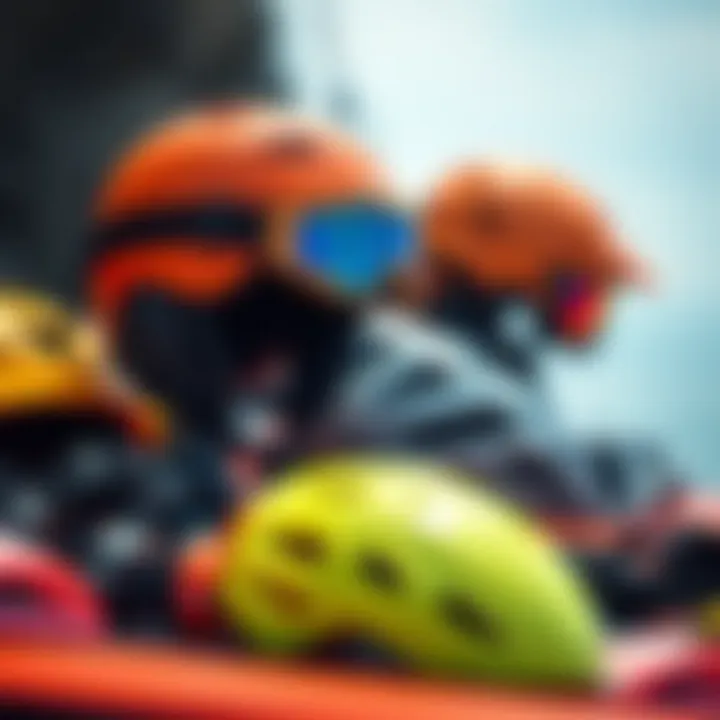
The ropes connecting your kite to the control bar—quite simply known as lines—are essential for effective kite handling. The length of the lines can affect the kite's responsiveness and how it behaves in different winds. Most common lines are either 20 or 24 meters long, with longer lines promoting more power and taller jumps, while shorter lines can provide better control, particularly for beginners. In this article, it’s pivotal to understand that your line choice should reflect not just your skill level, but also your style of kiting. The lines' material—often Dyneema or spectra—offers impressive strength-to-weight ratios that contribute to performance without unnecessary bulk.
However, it’s worth noting that the right lines require regular inspection. Fraying or wear can lead to failures, which is certainly not something you want cutting your session short. High-quality lines might come with a higher price, but the long-term gains, both in performance and safety, are certainly worth the investment.
Understanding Bar Width
Navigating the waters of bar width is also crucial when buying kitesurf gear. The width of the control bar impacts how you interact with your kite. Wider bars generally offer more leverage, which is beneficial in strong winds, allowing quick input to the kite. However, there’s a catch; using a bar that's too wide can lead to excessive strain on less experienced kitesurfers. A good rule of thumb is to match the bar width with the width of your kite for the best feel and handling. Bars also come with varying amounts of throw, which is how far you can pull it towards you; knowing this will influence your tuning and riding style.
Footstraps and Pads
Types of Footstraps
Footstraps might not seem like a big deal, but finding the right type can save you from unnecessary discomfort, especially on longer rides. There are a few distinct types of footstraps to consider. Classic straps offer adjustable options for fitting snugly, while the oversized ones provide extra support for larger feet or thicker boots. This variety allows a rider to effectively choose the right fit and feel, thus enhancing their maneuverability on the water. It's crucial when shopping to think about the conditions you’ll be riding in, as some straps are designed more for comfort on flat waters while others excel in harsher conditions.
Importance of Comfort and Fit
We can’t stress enough how vital comfort is when it comes to kitesurfing, and this applies equally to footstraps. A well-fitted strap ensures you have the right balance and control, especially when performing tricks or handling challenging wind shifts. If a strap is too tight, it could lead to foot fatigue; if too loose, it might cause instability. Take into account the materials used in footpads too; some provide a cushy feel, while others might be firmer for more control. Regardless of your skill level, exploring footstraps that prioritize comfort can improve your enjoyment significantly. Ensuring fit and comfort allows you to immerse fully in the experience, letting your skills take center stage without distractions.
"The right gear may not guarantee a perfect ride, but it sure as hell can make it a lot more enjoyable."
By paying attention to these often-overlooked accessories, you consciously elevate your kitesurfing journey. These choices can significantly impact your performance, comfort, and even safety on the water. Whether you’re a beginner just entering the sport or an experienced rider refining your equipment, understanding these elements ensures you make informed choices and enjoy your time kitesurfing.
Assessing Your Skill Level
Understanding your skill level in kitesurfing is like having a compass in uncharted waters. It helps you navigate the myriad of equipment decisions you'll face. A kiteboarder's skill level dramatically influences the type of gear they should invest in, from kites to boards, safety equipment, and even accessories. Tailoring your purchase to your abilities not only enhances your performance but also promotes safety on the water. More experienced riders tend to seek higher-performance gear that matches their advanced skills, while beginners benefit from equipment designed to facilitate learning.
Beginner Considerations
Simpler Equipment Choices
When starting out, selecting simpler equipment choices can make all the difference in your kitesurfing journey. For beginners, options like larger and more stable kites are often recommended. These kites are typically more forgiving in changing wind conditions, which helps novices keep control and stay safe. A key characteristic of simpler equipment is its intuitive design, specially crafted to ease learning curves. For example, a larger Leading Edge Inflatable Kite is less likely to drop out of the sky than a smaller model, empowering beginners to gain confidence without the steep learning curve associated with high-performance kites.
However, a downside might be that these beginner kites could limit performance as skills improve, potentially leading some to feel they are lacking when they gain experience. Yet, starting simple is undeniably better than starting complicated.
Prioritizing Safety
Safety shouldn’t be a secondary thought; it’s integral to your kitesurfing experience, particularly as a beginner. Investing in reliable safety gear, like a harness and impact vest, provides not only physical protection but also peace of mind. Prioritizing safety means you are fully engaged in learning without the constant fear of mishaps. For instance, using a waist harness instead of a seat harness could provide better mobility, allowing for easier transitions while you master your skills.
One unique feature of focusing on safety gear is that many pieces come equipped with functions like quick releases, which are critical in an emergency. While this armor might add to initial costs, the benefits far outweigh any financial concerns, as injuries can lead to long-term setbacks in your kitesurfing journey.
Intermediate and Advanced Gear
Performance Equipment
For those advancing in their kitesurfing journey, performance equipment becomes more about personal style and maximizing potential. Performance gear such as specialized freestyle boards and customizable kites can significantly enhance your riding experience and provide the speed and control necessary for executing tricks. A key characteristic of this type of gear is responsiveness; performance equipment often reacts quickly to riders' inputs, making it suitable for those looking to push limits.
Bear in mind, though, that performance gear can be more finicky in terms of set up and conditions. For instance, a small, lightweight kite can excel in strong winds but may be difficult to control in lighter conditions. Understanding your own capabilities and rarely riding beyond them will be essential for maintaining enjoyment.
Customization Possibilities
Customizability is a thrilling part of kitesurfing at an intermediate or advanced level. It allows riders to fine-tune their gear to match their specific needs and style, fostering a deeper connection between the pilot and the equipment. Customization possibilities can include choosing different fins for a board or adjusting the bar settings according to personal preferences.
An appealing aspect is that many brands offer options, giving you the flexibility to adapt as your skills evolve. However, this can also lead to analysis paralysis; with so many choices, it might be hard to decide what’s essential versus superfluous. Striking a balance between personal touch and practicality will help ensure that the equipment serves its purpose rather than becoming a source of distraction.
"Assessing your skill level is not just a preliminary step. It shapes the whole trajectory of your kitesurfing adventures, influencing not only gear selection but also safety, enjoyment, and growth in the sport."
In understanding and assessing your skill level, you gain power over your equipment choices, ensuring safety and performance at every stage of your kitesurfing journey.
Evaluating Local Conditions
When it comes to kitesurfing, finding the right spot isn't just about looking for a pleasant beach or a picturesque landscape. Evaluating local conditions is a fundamental part of ensuring a safe and enjoyable experience on the water. Certain aspects must be taken into account, from wind patterns to the nature of the water surface, all of which can dramatically affect your ride. Understanding these elements helps you make informed decisions, particularly when it comes to selecting the right equipment and technique for a successful day out.
Understanding Wind Patterns
Consistent Wind Locations
Finding a consistent wind location is like striking gold for a kitesurfer. The key characteristic here is the reliability of the wind. Areas with steady winds provide a more predictable riding experience. For instance, coastlines that are known for trade winds, such as those found in parts of Brazil or the Caribbean, often attract kitesurfers year-round.
These spots usually have wind speeds that range between 12 to 25 knots, which is ideal for this sport. Consistent wind locations are advantageous because they allow you to hone skills without the constant interruption of fluctuating winds. However, it's essential to keep in mind that even the most reliable spots can experience sudden shifts in conditions due to weather fronts or local terrain changes. Therefore, always check local forecasts and talk with other kitesurfers when you arrive.
Variable Wind Influence
In contrast, areas with variable wind influence can be challenging yet rewarding for seasoned riders. This variable wind may come from land breezes, thermals, or even gusty conditions created by surrounding landscapes like mountains or buildings. The beauty of these places lies in their unpredictability, offering a unique challenge for advanced kitesurfers who thrive on testing their limits.
However, navigating variable wind can be a double-edged sword. While it presents an exciting opportunity for skill growth and creativity, it can also lead to mishaps if the wind suddenly dies out or shifts direction dramatically. Being prepared for these conditions means having an adaptable mindset and possibly a range of kites to match those unpredictable winds, turning potential frustrations into exhilarating experiences.
Water and Terrain Types
Flat Water vs. Choppy Conditions
Water conditions can significantly affect your kitesurfing experience, and distinguishing between flat water and choppy conditions is crucial. Flat water, typically found in lagoons or sheltered bays, is often seen as the best setting for beginners. Here, riders can easily maintain stability, allowing them to focus on learning new tricks without the distractions of waves or turbulence. Flat water provides the optimum environment for practicing jumps and developing those precision maneuvers.
Conversely, choppy conditions, prevalent in open ocean waters, can give a more thrilling challenge to seasoned riders. While they might be more demanding on the body and equipment, these conditions often allow for bigger waves and faster riding speeds, which is enticing for intermediate to advanced kitesurfers looking for adrenaline-fueled sessions. The risk lies in the possibility of injuries or equipment damage due to the rougher nature of the waves; thus, understanding your skill level is key before tackling these waters.
Reef and Shoreline Terrain
The terrain where you choose to kiteboard also plays a critical role. Reef and shoreline terrain presents distinct advantages and challenges. Reefs can create fantastic waves that are ideal for advanced kiteboarding, offering exhilarating opportunities for tricks and jumps. However, they also pose a threat due to sharp and jagged edges. Mishaps can lead to injuries or equipment damage if riders are not cautious.
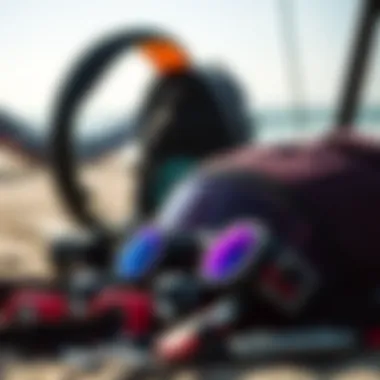
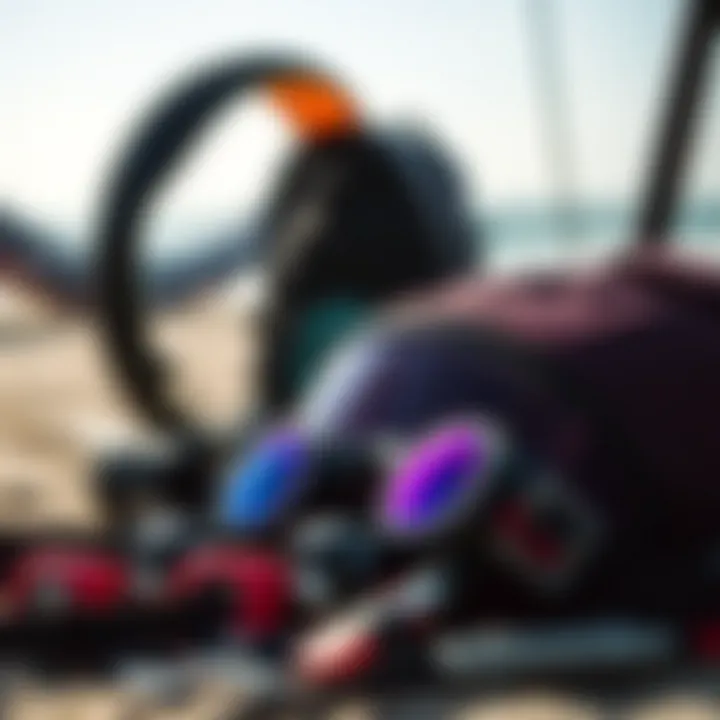
On the other hand, shoreline spots may be more forgiving for beginners, providing smoother landings and safer exits. Yet, they may also come with obstacles like crowded areas or limited space. Riders should evaluate whether they plan to practice tricks or just enjoy a leisurely ride when choosing a location.
Evaluating these local conditions not only enhances your kitesurfing experience but also prepares you to make smarter decisions about the equipment you choose to buy and use. As they say, the early bird catches the worm—being proactive about checking out these elements can make all the difference.
Budgeting for Kitesurf Equipment
When stepping into the realm of kitesurfing, one of the most crucial aspects to consider is budgeting for kitesurf equipment. This isn’t just about throwing cash at the latest and greatest gear; rather, it's about understanding the parameters of what you need, how much you're willing to spend, and what value you expect in return. Financing your kitesurfing endeavors can heavily influence your experience on the water, and mismanagement here could lead to expensive mistakes.
Initial Investment vs. Long-Term Value
Balancing Quality and Price
One of the most significant decisions you’ll face when purchasing kitesurf equipment is balancing quality and price. It’s tempting to opt for the cheapest option, especially if you’re a newcomer. However, higher-quality items typically offer improved performance, durability, and safety. Think of it this way: skimping on gear could lead to hazardous situations out on the waves. A wager worth taking is investing in solid gear that lasts.
A top-tier kite may cost more upfront, but it often delivers a better ride experience. A notable characteristic of this choice is that a good investment tends to show its worth through superior handling and long lifespan. Saving a few bucks in the beginning may seem prudent, but penny-wise, pound-foolish comes to mind when thinking of future repairs or replacements.
Potential Resale Value
Another important aspect to consider is the potential resale value of your equipment. High-quality, well-maintained kitesurf gear can often be resold for a significant portion of what you originally paid. This can help offset the cost when it’s time for an upgrade or if you decide kitesurfing isn’t for you. Often, certain brands and models hold their value better than others, making them a more prudent investment in the long run.
However, you need to mind the unique features that differentiate your gear—like limited edition kites or boards with unique technology—that make them desirable to others. On one hand, you might lose some investment if you buy trendy items that fall out of fashion or are not scientifically backed, while on the other, classics often retain value.
Tips for Cost-Effective Purchases
Used Equipment Considerations
Buying used equipment can be a game-changer for your kitesurfing budget. There’s no denying that you can save a fair amount of dough if you’re willing to shop around. The key is ensuring the equipment you’re considering is still in good condition and won’t put you at risk. Check for any wear and tear, and ask about its history from previous owners.
A characteristic feature of used equipment is that it can often deliver fantastic value, allowing you to snag premium brands at a reduced price. It’s important to approach this avenue with caution, though. If you’re not well-versed in assessing kitesurfing gear, you might find yourself stuck with something that falls short of quality and could lead to accidents.
Seasonal Sales Opportunities
Another excellent avenue for cost-conscious shoppers is seasonal sales. Typically, just after summer winds down, retailers will start marking down their stock to make way for the next year’s model. This can lead to substantial savings, especially on kites and boards that are still top-notch but carry last year’s design.
The unique feature here is that many retailers and online platforms offer discount codes, bundles, or promotions around major holidays, which can further slash costs. However, you must act fast—great deals don’t stick around long. Keep your eyes peeled and your wallet ready, as these opportunities can significantly enhance your early investment into kitesurfing.
Always remember: a well-planned budget today will save you potential headaches tomorrow.
In summary, budgeting for kitesurf equipment isn’t just about paying attention to the bottom line. It’s understanding the intricate balance of initial expenses, long-term value, and cost-effective purchasing strategies. By doing your homework and planning wisely, you can navigate this thrilling sport without breaking the bank.
Where to Buy Kitesurf Equipment
Finding the perfect kitesurf equipment is not just about knowing what you need; it’s also crucial where you decide to purchase it. The location and method of buying can significantly influence your experience—both in terms of cost and quality. This section provides insights into the avenues available for kitesurf equipment shopping, focusing on online options and local shops. Understanding these channels will help kitesurfers make informed choices, maximizing both their budget and gear effectiveness.
Online Retailers
Online retailers have revolutionized how enthusiasts purchase kitesurf gear. The convenience of browsing from the comfort of your home and the sheer volume of options available can make or break your shopping experience. Here’s a closer look at two primary types of online retail options.
Comparative Websites
Comparative websites serve as a one-stop shop for those looking to balance price and quality. These platforms allow users to view a range of products from different retailers side by side.
This feature enables price comparison, letting you hunt for the best deal without jumping from one site to another. Additionally, many comparative websites offer user reviews, providing insights into product performance that can be invaluable.
However, not all sites are created equal. Sometimes the information can be outdated, leading to unavailable products or incorrect pricing, which is definitely a drawback. One standout example is Kitefinder.com, which specializes in kitesurf equipment, helping buyers navigate through options effectively.
Manufacturer Websites
Purchasing directly from manufacturer websites can be both a reliable and beneficial approach. Brands like Naish and Cabrinha often list their latest products alongside a wealth of knowledge on product specifics. The direct line from manufacturer to consumer often means better pricing and exclusive deals.
Also, buying from these sites guarantees you’re getting authentic gear, which is vital for safety and performance in kitesurfing. One caveat here is that manufacturers may not always have the best prices. Also, the range of products might be limited compared to larger online stores. However, for serious kitesurfers, getting gear directly from the source might provide peace of mind.
Local Shops and Specialists
While online shopping has its perks, it can’t quite replace the benefits of visiting local shops, especially when you’re new to the sport or looking for specialized advice. Local stores can provide invaluable resources that may not be as easily accessible online.
Benefits of Local Knowledge
Shopping at local kite shops offers the advantage of first-hand knowledge. Staff members are often passionate about kitesurfing and can provide personalized recommendations based on your skill level and local conditions. This intimate understanding of the sport allows them to guide you toward the best equipment that fits your needs.
Additionally, many local shops often host events, demos, or workshops that can help you understand equipment before purchasing. However, the downside could be limited stock or higher prices compared to online retailers. But the ability to see and feel the product can offset those concerns for many buyers.
Community Support and Networking
The community aspect of local shops cannot be understated. Engaging with fellow kitesurfers in person fosters a sense of belonging and support. Local shops often serve as hubs, providing the chance to network with other riders, learn from seasoned professionals, and get insider tips about the best spots to ride.
These connections can be essential, especially for beginners looking to break into the sport. Local shops may also have bulletin boards with information on sales, swap meets, or fellow kitesurfers offering gear for sale. It’s an ecosystem that can significantly enhance your kitesurfing journey.
Overall, deciding where to purchase your kitesurfing gear involves weighing the pros and cons of online retailers and local shops. Each option has something unique to offer, and understanding these can help you make an informed decision that aligns with your needs and expectations.
The End
Understanding the purchasing process for kitesurf equipment is often overlooked, yet it’s a crucial part of ensuring a successful kiteboarding experience. In this guide, we've explored the foundational elements ranging from the types of kites and boards to the essential safety gear. But let’s take a moment to reflect on the importance of synthesizing all this information.
When you stand on the precipice of investing in gear, knowledge comes into play like the wind behind your kite. It’s not merely about how much money you can drop; it’s about making choices that align with your skill level, local conditions, and intended use. Buying inappropriate equipment can lead to either frustration or dangerous scenarios — neither are appealing.
Key Elements to Consider:
- Personal Skill Level: Recognizing where you fit on the skill continuum helps guide your purchases. Beginners might seek more stability and ease, while advanced riders often prioritize performance tweaks.
- Local Conditions: Each location offers unique challenges, and understanding your environment’s wind and water conditions allows for smarter purchases. Flat water? Go for different boards than you would in choppy seas.
- Budgeting Wisely: The initial cost matters, but so does long-term value. Think resale opportunities and the durability of your gear. You wouldn’t want to find yourself midway through the season wanting to replace your kite because it’s falling apart, right?
With benefits spread across various aspects of kitesurfing, this guide aims to equip you with the groundwork necessary to navigate your journey. The right gear can spark the difference between simply scratching the surface of this exhilarating sport and truly riding the waves like a pro.
"A kiteboard is more than just equipment; it’s the bridge between you and the ocean's heartbeat. Choose wisely."
Take your time to reflect on your choices, and don’t rush the decision-making process. The right equipment paves the way for unforgettable experiences, freedom, and joy out on the water.
